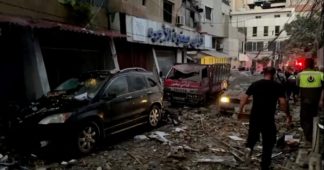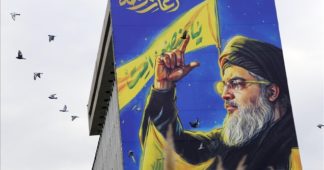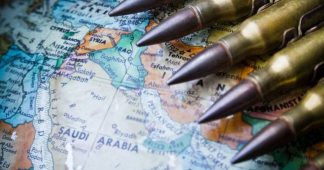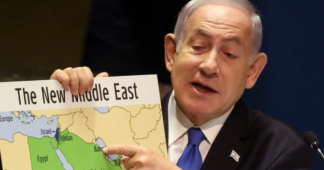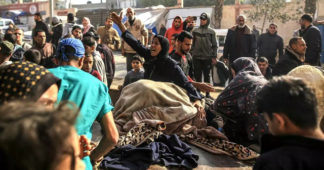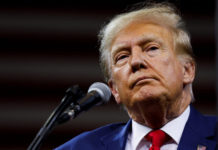by Ecaterina MAŢOI
The recent picture of an Israeli Defense Forces (IDF) soldier with a Greater Israel badge on the uniform provoked outrage in Arab countries (Middle East Monitor, 2024). The promised land of Israel, as described in the badge photo, includes regions from the Nile to the Euphrates, from Medina to Lebanon, including territories from Egypt, Lebanon, Syria, Iraq, Saudi Arabia, entire Jordan, and Occupied Palestinian territories. Why it sparked outrage, however, is not clear: the map reflects Theodor Herzl’s more than a century old statement: “Discussed with Bodenheimer the demands we will make. Area: from the Brook of Egypt to the Euphrates…” (Herzl, Ed. Patai, & Transl. Zohn, 1960, p. 711), and with newer instances of this territorial expansion desiderate, expressed by Oded Yinon plan and Saul B. Cohen’s geopolitical concepts, among others, and the aggressive stance against Israel’s neighbors and regional countries. Hence, it is probably not the existence of the plan that sparked outrage, but its appearance in the broader social media space.
This view on region’s future is neither new nor rare. In a January 2024 recording, Israeli politician Avi Lipkin was stating: “… eventually, our borders will extend from Lebanon to the Great Desert, which is Saudi Arabia, and then from the Mediterranean to the Euphrates. And who is on the other side of the Euphrates? The Kurds! And the Kurds are friends. So we have Mediterranean behind us, the Kurds in front of us, Lebanon, which really needs the umbrella of protection of Israel, and then we’re gonna take, I believe we’re gonna take Mecca, Medina and Mount Sinai, and to purify those places” (muslimi.official, 2024), (Middle East Monitor 1, 2024).
This article analyzes the geopolitical and international relations implications of Israel’s expansion plan in the Middle East and North Africa (MENA) region, in connection with the dynamic concept of Greater Israel, from a historical development perspective.
1. Geopolitical lens considerations and Israeli assertions
Rudolf Kjellen’s “geopolitik” was defined at the end of 19th century, and according to literature, the developed framework encompasses also the “organic concept of statehood” (Tunander, 2001, p. 453), along with other concepts like “state and land”, unity, people, personality of a state on the international scene.
Post-World War II literature on geopolitics began to criticize and revise initial geopolitical hypotheses defined by Mahan, Mackinder and Haushofer, among others. For example, Sprot was stating in 1953: “Very few of these hypotheses reflect dispassionate objectivity. Most of them reflect a specific nationalistic viewpoint; most of them were formulated in the heat of some kind of a crisis, in a period of tension; most of them reflect advise to a particular government – a policy which, if followed, it was hoped would achieve some desired result” (Sprout, 1954, p. 20). While the arguments hold true, it was also the association of geopolitics with Friedrich Ratzel’s Lebensraum conceptual framework and its instrumentalization by the German Nazis that led to a “divestment” from geopolitics as a discipline in the mid 20th century.
In principle, geopolitics was concerned with the distribution of (state) power across regions and the globe, i.e., geographical regions, from the perspective of theoretical developments and political practice. It expanded on the previous military power concepts, and the association of states with organisms was probably another embodiment analogy, like for example Planet Earth as a living organism: Gaia.
Geopolitics was supposed to deliver answers and support in addressing various issues for different decision-makers at a certain point in history. From this perspective, it is connected to a state’s external policy and international relations. It thus evolved from the beginnings of the 20th century to the Cold War theses, the subsequent American unipolarism and the post-2001 American War-on-Terror (WoT) approach. Should one consider China’s Belt and Road Initiative (BRI) as a geopolitical shift, at least a part of the world has moved into a geopolitical setting in which international influence is not resulting from a direct military confrontation with other countries.
However, following classical geopolitical criteria are retained for this study: the dynamic character of a state’s international stance, which according to certain theories, not reflected in present mainstream international relations practice, included the dynamics of borders, the state-centered view on international relations and the concept of state power. The newer “critical geopolitics” literature approaches questions, among others, the self-proclaimed universal character of Western geopolitical concepts, arguing also that after the Cold War, the world has not achieved peace. It also theorizes that geopolitics is “a broad cultural phenomenon” and “its value is not politically neutral” (HU & Dadao, 2016). The following criteria will be added to the geopolitical analysis framework from this article: the relative universalism of demands and the political discourse as distinct tool in achieving geopolitical goals.
No geopolitical theoretical framework can exhaustively describe the evolution of Israel’s power relations with its neighbors and other countries. The classical approaches served the pre-World War II international relations and the subsequent versions also tend to support the view of a particular power center. Therefore, following research directions will be considered in subsequent chapters: the notion of a dynamic state as argument for geopolitical demands, state-centered approach to international relations, universalism of hypotheses and evolution of political discourse as a tool. Instead of filtering the Greater Israel project through a particular lens, this article will analyze three main instances of Israeli geopolitical views/expressions related to Israel’s role as a state vis-à-vis broader international principles and consensus on peaceful coexistence reflected in the United Nations Charter: the Greater Israel maximalist demands expressed in Theodor Herzl’s diaries, the Oded Yinon Plan and more recent geopolitical definitions provided by Saul Cohen, which appear to consistently point towards the direction of an Israel taking over further territories of/from its neighbors.
2. Israeli demands and implications
2.1. Theodor Herzl and the Zionist Movement
Theodor Herzl is not the first proponent of a Jewish state. However, the history of territorial claims to land from Palestine will however not be analyzed in this article. It dates back at least a couple of centuries ago and Palestine was not the only option considered for a Jewish state before Balfour Declaration: the Uganda option, among others, was rejected by the World Zionist Organization at the beginning of 20th century. However, his and his group’s work resulted in the 1948 foundation of Israel as a state, and what the Palestinians call an-Nakba, i.e. the mass, forced, displacement of inhabitants from the future land of Israel. Adrian Stein explains that Herzl personally organized the first Zionist conference between 29th and 31st of August, 1897 at Stadtcasino in Basel (Stein, 2024). In Book 6 of Herzl’s diaries (beginning in 1898), Herzl describes a discussion he had with (German) Imperial Chancellor, Prince Hohenlohe, in which he is asked how much land is expected to be needed for the envisioned state. His reply was: “We will ask for what we need – the more immigrants, the more land.” In the same discussion, he explains: “We want autonomy and self-protection” (Herzl, Ed. Patai, & Transl. Zohn, 1960, pp. 701-702).
Territorial demands mentioned in various instances of this book vary in formulation, but they essentially describe a territory larger than Israel 1967 broadly recognized borders or the ones of Palestinian occupied territories. An example is: “I wrote on a slip of paper…: Sinai Peninsula, Egyptian Palestine, Cyprus … Sinai – El Arish – Cyprus plan…” (Herzl, Ed. Patai, & Transl. Zohn, 1960, pp. 1294-1295). In the discussion with Bodenheimer related to the area “…from the brooks of Egypt to the Euphrates…” described in Book Two (Herzl, Ed. Patai, & Transl. Zohn, 1960, p. 711), the plan of a two-stage process was discussed, with the aim to introduce it to the Ottoman government: initially a Jewish governor (under Ottoman sovereignty, similar to the Egyptian relation with the Sultan) and as soon as the Jewish population surpasses two thirds a complete Jewish administration.
There are many details related to Zionist developments from this period, but from the perspective of state dynamics as a criterion in this study, Balfour Declaration was not approved yet by the British government. The world had not yet begun to decolonize, and the Ottoman Empire was in regression, allowing colonial powers like the United Kingdom and France to increase their influence in Ottoman territories. In the territory of Ottoman Palestine, the state-centered approach was appearing in the form of national aspirations as defined by the mandates, i.e. an auto determination that also abolished the Ottoman Empire.
It is rather difficult to identify the universalism degree of Herzl’s demands for land. There is a broad agreement among researchers that the Bible does not represent a scientific historical source, hence the narrative of return to Israel, or Greater Israel can be associated with an argumentative discourse, not a detailed history of the region or demographic realities on the ground. Without denying this possibility, it can also observed that the demand looks like deal proposals for certain decision-makers at certain times in history, rather than a clear delimitation of territory: it can be maximalist, in order to obtain as much as possible through negotiation, and it is presented as dynamic when replying to Prince Hohenlohe that more migrants will require more land. Another relative aspect of land demand is the readiness to buy the land from Arab and Greek owners (Herzl, Ed. Patai, & Transl. Zohn, 1960, p. 702). Should this land had been Israeli, why buy it from existing, lawful owners? And should the thesis of “barren” land, propagated in the media, or “vacant land” (Herzl, Ed. Patai, & Transl. Zohn, 1960, p. 1363) holds true, again, why buying it? Consequently, it can be asserted that the character of Herzl’s land demands is not universal. While there were reasons for the Zionist Movement to consider founding an independent Jewish state, the location and modality to implement such a project were subject to longer, previous negotiations with power guarantors of those times, i.e., the former colonial powers, Germany and later the United States. These were subjective agreements.
In 1948, the State of Israel was founded on inhabited Palestinian lands and although land has been bought, reportedly more than 750,000 Palestinians were forcefully displaced from their homes. The displacement of Palestinians and conflicts in the Occupied Palestinian territories continue to take place. Israel also fought wars with its Arab neighboring countries on more occasions, and the region remains relatively unstable.
2.2. The Oded Yinon Plan
The autonomy and self-protection goals stated by Herzl were achieved, although the self-protection aim is heavily reliant on American and European military aid to this day. In the 1982 essay “A strategy for Israel in the Nineteen Eighties” by Oded Yinon (Yinon & Shahak, 1982), further geopolitical ideas related to the region are discussed, in line with Israel’s position and conflicts with its neighbors. This can be equated with a handbook for dissolution of Arab countries. Author’s (Yinon) claims that the world transits to a “new epoch in human history”, can also be seen as a truism: every day is a new day for the entire humanity and the establishment of epochs is different for different cultures despite the increase of globalization. The paper identifies Israel along Western world, mentions the threat of a “multi-dimensional global war” and “the dimensions of the global confrontation which will face us in the future”. It is a paper on war essentially. After extensively presenting various diversity aspects of Arab societies, some of them being cosmopolite for centuries anyway, including Algeria, Egypt, Lebanon, Syria, Saudi Arabia and Iraq, the “plan” begins to present “dissolution” scenarios for these countries along religious or ethnical lines: a “Christian Coptic State” in Egypt, that could lead to “downfall and dissolution of Egypt,” in its turn triggering the fall of Libya and Sudan. The article further states: “Lebanon’s total dissolution into five provinces serves as a precedent for the entire Arab world including Egypt, Syria, Iraq, and the Arabian Peninsula and is already following that track. The dissolution of Syria and Iraq later into ethnically or religiously unique areas such as in Lebanon, is Israel’s primary target on the Eastern front in the long run, while the dissolution of the military power of those states serves as the primary short-term target. Syria will fall apart, in accordance with its ethnic and religious structure, into several states such as in present day Lebanon, so that there will be a Shi’ite Alawi state along its coast, a Sunni state in the Aleppo area, another Sunni state in Damascus hostile to its northern neighbor, and the Druzes who will set up a state, maybe even in our Golan, and certainly in the Hauran and in northern Jordan. This state of affairs will be the guarantee for peace and security in the area in the long run, and that aim is already within our reach today” (Yinon & Shahak, 1982). This long citation is representative for the Israeli divide et impera view on the region and at least a part of its acting directions, and a conflict between Iraq and Iran was expected, according to the article, to lead to Iraq’s dissolution, which Yinon defined as “…more important for us than that of Syria.” The article uses questionable terms like for example “…liquidation of Jordan under the present regime….”
Ralph Schoenmann, an author criticized for “personal ideological bias” and attributing “some of Israel’s misdeeds to US instigation” (Killgore, 2024), lists in his book, “The Hidden History of Zionism” (Schoenman, 1988, pp. 103-113), what he calls a “Strategy for Conquest” based on the analysis of Yinon’s plan: divide and rule, dissolving Lebanon and fragmenting Syria, an “assault” on Iran, targeting Iraq, “double-crossing Mubarak”, weakening Saudi Arabia and dissolution of Arabian peninsula states and depopulation of Palestine. Schoenman claims that Yinon’s ideas were not isolated: they had been presented by Ariel Sharon and Moshe Arens, as well as the Labor Party. He also lists the four “NOs” of Labor Party’s 1984 political platform: NO to a Palestinian state, NO to negotiations with Palestinian Liberation Organization (which must be assessed from the perspective of results), NO to the 1967 borders and NO to the removal of settlements (Schoenman, 1988, p. 113).
In the 1980s, Israel was already a dynamic state, with new territories occupied after the 1967 war and maintained in the 1973 war, and with an ongoing settler colonialism project (Gluskin, 2018).
The approach remained very state-focused, and the only focus was basically the State of Israel, while the (Yinon) plan saw all surrounding and other Arab states as candidates for dissolution based on ethnical or religious criteria.
2.3. Saul Cohen’s geopolitical definitions and other current views
Saul Cohen’s “Geopolitics” was published initially in 2003, and republished in 2009 and 2015 (Cohen, 2015). Two aspects of his work appear to confirm a geopolitical view that are connected with Israel’s regional situation and its geopolitical constraints: the definition of a nation’s claim to power and the concept of geopolitical structures that includes “highly autonomous regions” and “quasi states”.
The four pillars of a nation’s claim to power mentioned in his book are: an overwhelming military strength and the will to use this power, “surplus economic energy” to be provided as aid or investment to other countries, ideological leadership, and a cohesive governance system (Cohen, 2015, p. 2). While his work is generally very descriptive on Western concepts, this definition can be perceived rather as a definition of US military power if one considered the first two pillars. Assuming that Israel is still working on the development of economy, and that overall military power included massive exogenous support, the claim of Israel to power could be eventually accommodated in a regional setting. Although the author does not detail on superpower competition’s impact on Israel, the work states that “radical geopolitical restructuring is a continuous process” in the context of an increasing number of states on the globe, and an advance of multipolarity and regionalism. Potentially as a confirmation of Oded Yinon’s plan, the book also states that the Middle East “has become even more fractured as a shatterbelt” (Cohen, 2015, p. 33). Further confirming on Yinon’s dissolution view, Cohen claims that in approx. 25 years, the number of national states could increase from 200 to 250, in what he calls a devolution process.
However, although mentioning the “national states,” Cohen immediately switches to the notion of “these new geoterritorial entities” that are expected to become highly autonomous “quasi states,” and not national states as initially mentioned. Another term that appears to confirm the idea of possible dissolution of states is that of (national) state’s “demise”, associated in this book with strengthening of world and regional governing bodies, influence of Non-Governmental Organizations (NGOs), economic developments, etc. (Cohen, 2015, p. 49). Cohen even suggests regions with the potential to become, in his view independent or quasi states: Quebec, Crete, Catalonia, Scotland, Wales, Chechnya, Somaliland, Arab Palestine, (Iraqi) Kurdistan, among others and possible new “confederations”, listing China and Taiwan, Former Yugoslav states and the Baltic States, among others (Cohen, 2015, pp. 57-59).
In Chapter 12, “The Middle East Shatterbelt”, the author presents a map (fig. 12.1) that includes Turkiye in the “shatterbelt” region. The map does not mark large parts of Saudi Arabia, Iran, Egypt, Yemen as “Effective National Territory.” Neom, for example, was not marked as an Effective National Territory in this book. It marks the entire Israeli territory either as ecumenes or effective national territory, a small part of West Bank and no region from Gaza as effective national territory. Most of Jordan’s territory is also not marked as Effective National Territory. Ecumenes are defined as “areas of greatest density of population and economic activity” and Effective National Territories and Effective Regional Territories as “moderately populated areas with favorable resource bases” (Cohen, 2015, pp. 39-40).
All these concepts appear to support/justify Israel’s regional expansion aspirations, and previous concepts like “barren”/” vacant” land. Although this book is a theoretization and probably author’s opinion, this type of opinion has the potential to move the discussion from the “territorial integrity or political independence of any state” (UN Charter article 2) to another area in which regions from sovereign states, be they strong or weak, are not marked as Effective National Territories, based on subjective definitions. Of course, this does not directly infringe upon territorial sovereignty of these countries, but the possibility of interpretation cannot be ruled out especially in this terminology setting, and in the context of political declarations of certain Israeli politicians related to Ottoman Palestine: Jordan may feel threatened, Egypt as well, and President Erdogan stated in May 2024: “…if this … state of Israel is not stopped, it will set its eyes on Anatolia with its delusion of a promised land…” (Middle East Monitor 05, 2024). Another important concept from this book is that of “equilibrium”, along with turbulence and world order, from a system perspective, that, again points to a “developmental approach”, mentioning Herbert Spencer’s “organic growth analogy” (Cohen, 2015, p. 59).
Yossi Sarid published in 2011 an opinion on Haaretz website, according to which the two traditional pillars of Israel’s occupation were history and security, and called the back-then newly added pillar “not a pillar but a snake”, arguing against the alleged appearance of what he called the need for “lebensraum” (Sarid, 2011). His statement related to the security dilemma that Israel faces was: “The second, security-based school of thought stipulates that we need virtually all the territories for self-defense” (Sarid, 2011). While it is not clear whether the author identifies with this statement or not, the reflection emphasizes on an argument that serves both the security of Israel and the Greater Israel expansionist cause.
The leitmotif of “new age” or “new era” continues to be employed in multiple instances. In Adrian Stein’s blog series (Stein 2, 2024), Mr. Stein explains that “Zionism 2.0” is set to establish “the foundation for a new emerging civilization centered and based in Israel, propelled by Israel’s culture, language and gifted people”. The scope is global, according to the author: “Zionism 2.0 seeks to alter and transform the existing material and economic basis of the world, and through these efforts give rise to a new global structure or civilization if you may”. Technological, scientific development is envisioned, along with the spread of start-ups.
Therefore, how is Greater Israel goal reflected in contemporary literature and media reports analyzed above? Probably the most important aspect is that it is not much different than it was at the beginning of 20th century, or the 1980s, from the geopolitical perspective. Adrian Stein utilizes the title “From the Euphrates to the Nile” (Stein 2, 2024), Saul Cohen insists on the same terminology that accommodated overtaking land by force and by defining characteristics for the so-called “new” ages. The theses that appear to drive the Greater Israel expansion appear to be connected to the notion of a dynamic state, in the sense of territorial expansion for Israel if one considers the security threat discuss above, and the dissolution of Arab states discussed in the Oded Yinon plan. All materials analyzed appear to have been state-centered, irrespective of their direction. The universalism character of geopolitical hypotheses appears to be rather inexistent and inconsistent from a possible replication perspective. Likewise, the universalism of claims related to a potential new global civilization centered in Israel is yet to be demonstrated. And even if it was demonstrated, there is no clear hint on how long such a civilization could potentially last.
The political discourse development as a tool in supporting greater Israel (Behnam, 2023) is reflected by the refinement of “hasbara” policy, i.e. the Civic Public Diplomacy. This is equated with “the control of Narrative as an Element of Strategy” by Ambassador Chas W. Freeman (Freeman, 2024), with “Art of Deception” by a TRT World article (TRT World, 2021), and with a “propaganda machine” by Sam Hamad (Hamad, 2023).
3. Potential geopolitical implications of Greater Israel project
Although not new, the Greater Israel project appears to receive renewed attention in the light of the most recent war from Gaza, that reportedly led to the death of more than 34,000 and wounding of over 78’000 Palestinians, and the prospect for a potential war in Lebanon.
This recent Gaza development appears to at least pause the Abraham Accords with Saudi Arabia, but should Israel pursue its Greater Israel project, whose maps match Herzl’s territorial demands and clearly hints at extending its territory in Saudi Arabia, including Neom and according to Avi Lipkin Mecca and Medina, the envisioned regional peace becomes an unclear concept. There is no long term, core concept identified in analyzed publications that hint at a possible restraint of Israel from expanding its territory. It is thus difficult to distinguish, based on analyzed data, between a potential strategic patience of Greater Israel planners – that could envision a longer timing for this project and a step-by-step approach, and a potential agreement between Israel and Saudi Arabia along other neighbors, to form a sort of alliance/union with a map that the Israeli soldiers recently displayed. However, given the situation at this point in history, and the historic tendency of Israeli strategists towards a state-centered approach, the latter option is probably unlikely.
The regional geopolitical dynamics appear to be marked by various forms of conflict that hint towards an active Greater Israel project, a potential normalization of relations between Saudi Arabia and Israel, and an increasing confrontation between Iran and its allies and Israel, the US and their allies on the other hand. In this confrontation, Türkiye appears to play no significant role and Saudi Arabia appears to wait for a certain event to pick a direction. And this event would be reportedly the recognition (by Israel) of a Palestinian state.
Saul Cohen’s view was that global organizations tend to weaken state sovereignty. This state-centered approach was expressed, probably, from a geopolitical perspective that does not include the importance of trade. It must be however emphasized that Israel is relying particularly on the US, the UK, and other allies, rather than United Nations Security Council, to carry out its defense policy. Furthermore, the tensions derived from a potential arrest warrant for Prime Minister Benjamin Netanyahu by the International Criminal Court have resulted in a further distancing between Israel and international organizations.
The approach to Greater Israel project may determine various regional and global reactions. Until recently, the essentially grey line approach to the Occupied Palestinian Territories, which could be perceived as a long-term slow-pace settlement project, since it resulted in the increase of settlement units, along with what the media often calls Egyptian and Lebanese economic and financial “difficulties” have ensured a certain advancement of Israel outside its 1967 borders. However, although other successes were marked, like the recent Abraham Accords, it must also be emphasized that it was not able to maintain the occupation of Sinai peninsula or the puppet state it helped create and supported in Southern Lebanon back in the ‘80s. Likewise, although Syria is facing serious hardships, it did not disintegrate. Likewise, the deal that Ankara signed with Baghdad will probably increase security in the Iraqi Kurdistan region, rather than creating further potential for wider conflicts. From this perspective, the “shatterbelt” characteristic of this region appears to be a rather stable instability than an unstable one: no major geopolitical change has occurred so far and no border has been redrawn. Furthermore, states like Iran, Türkiye and Egypt have become very vigilant from this perspective, and Iraq appears to reemerge as a regional economic power that can catalyze regional power relations. These short-term regional tendencies appear to strengthen region’s capacity to react to a potential extension of Israel’s borders by force.
While Israel’s support in the US remains strong across the entire political spectrum, the political and economic costs of a potential broader war near Israel’s borders can rise for the traditional superpower. In the wider context of superpower confrontation paradigm, a generally increasing confrontational scene and a potential global arms race, whose alleged goals are self-defense, whatever the meaning is, American priorities may become more pronounced in this context. Whatever they might be.
A potential plan by Israel to become a trade hub/route connecting Europe to Asia, and to win leverage as a hydrocarbon supplier especially for Europe is facing challenges from more directions: China will probably remain a user of the existing Suez Canal. Probably India as well, unless it receives more economic and political incentives from the proponents of alternatives. Likewise, Türkiye is already an important hub for gas and oil pipelines and is emerging as a route for the Middle Corridor trade route as well. Hence, while Israel can offer alternatives to old and new trade routes, the same regionalism and multipolarity that Saul Cohen mentioned can lead to new economic development patterns that will demand Israel to imagine new, efficient regional policies, that could or could not rely on the same level of support from traditional security partners. Whether these potential new paradigms are compatible with the traditional and actual Greater Israel goal remains to be analyzed, primarily by Israel, its neighbours and its regional partners in the first instance.
4. Conclusions
This article aimed to characterize the “Greater Israel” concept from a geopolitical perspective. After analyzing classical and revisionist theories on geopolitics, four indicators were defined to assess the historical evolution of this term from the beginning of 20th century until present. The indicators were: the dynamic characteristic of a state, the (degree of) state-centered approach to geopolitics, universalism as a hypothesis in demands and negotiations, but also in political speech, and the (degree to which) political discourse is employed as a tool in implementing geopolitical goals, including Greater Israel project.
Three major instances of Israel’s foundation and development as a state were analyzed: the foundation negotiations carried out by Theodor Herzl and his supporters, the Oded Yinon plan and the 21st century geopolitical concepts presented by Saul Cohen and other writers. The data analyzed indicates a systematic, long-term, desire to achieve a Greater Israel that would stretch from Egypt to Iraq, potentially including regions from Lebanon, Syria, Saudi Arabia, Egypt and Jordan.
There is no clear indication that Israel would renounce this goal, or that it would compromise on Greater Israel project. However, the leitmotif that appears in the argumentation of Greater Israel project, i.e., the a perpetual “new” era/age, might indeed represent a reason for reflection. As the world is reportedly moving towards an end of big oil era, and trade routes multiply at global and regional level, new paradigm changes will be required for the traditional superpowers in order to peacefully compete with the emerging industrial and trade powers. And while Israel is enjoying autonomy and increases its stake in own self-protection, the importance of foreign support may still be a core component of its regional policy. When analyzing the Greater Israel project, one must consider whether a potential perpetual war state is compatible with aspirations towards a peace-time economic development, that is supposed to compete with new-era, fast-developing economic powers. Likewise, given the existing precarious security situation, it remains unclear what security guarantees can Israel and Arab countries can offer and ask to move towards a more predictable development.
Bibliography
Behnam, R. (2023, June 8). Hasbara Industry: Deconstructing Israel’s Propaganda Machine. Retrieved from The Palestine Chronical: https://www.palestinechronicle.com/hasbara-industry-deconstructing-israels-propaganda-machine/
Cohen, S. B. (2015). Geopolitics – The Geography of International Relations, Third Edition. Lanham, Boulder, New York, London: Rowman & Littlefield.
Freeman, C. (2024, June 23). Hasbara and the Control of Narrative as an Element of Strategy. Retrieved from Middle East Policy Council: https://mepc.org/speeches/hasbara-and-control-narrative-element-strategy/
Gluskin, R. (2018, October 29). Is It Antisemitic to Consider Zionism a Colonial Project? Retrieved from Evolve – Groundbreaking Jewish Conversations: https://evolve.reconstructingjudaism.org/isitantisemeticcolonialismzionism/
Hamad, S. (2023, November 18). Understanding Hasbara: Israel’s propaganda machine. Retrieved from The New Arab: https://www.newarab.com/news/understanding-hasbara-israels-propaganda-machine
Herzl, T., Ed. Patai, R., & Transl. Zohn, H. (1960). The Complete Diaries of Theodor Herzl, Volume 1. New York, London: Herzl Press and Thomas Yoseloff.
HU, Z., & Dadao, L. (2016). Re-interpretation of the classical geopolitical theories in a critical geopolitical perspective. Journal of Geographical Sciences, 2016, Vol. 26, DOI: 10.1007/s11442-016-1357-1, 1769-1784.
Killgore, A. (2024, June 23). Review: The Hidden History of Zionism. Retrieved from Washington Report on Middle East Affairs: https://www.wrmea.org/1989-august/book-reviews-the-hidden-history-of-zionism.html
Middle East Monitor 05. (2024, May 16). Erdogan says ‘rogue state’ of Israel will target Anatolia with its delusions of promised land. Retrieved from Middle East Monitor: https://www.middleeastmonitor.com/20240516-erdogan-says-rogue-state-of-israel-will-target-anatolia-with-its-delusions-of-promised-land/
Middle East Monitor 1. (2024, January 11). Israel’s borders will extend to Makkah, Madinah and Mount Sinai, claims Zionist writer. Retrieved from Middle East Monitor: https://www.middleeastmonitor.com/20240111-israel-borders-will-extend-to-makkah-madinah-and-mount-sinai-claims-zionist-writer/
Middle East Monitor. (2024, June 19). IDF soldier wears ‘Greater Israel’ badge, sparking angry reaction. Retrieved from Middle East Monitor: https://www.middleeastmonitor.com/20240619-idf-soldier-wears-greater-israel-badge-sparking-angry-reaction/
muslimi.official. (2024, January 10). Instagram post 10.01.2024: Israeli politician Avi Lipkin, founder of the Judeo-Christian ‘Bible Bloc’ party says “I believe we’re [Israeli] gonna take Mecca, Medinah and Mount Sinai and purify those places.”. Retrieved from Instagram: https://www.instagram.com/muslimi.official/reel/C17U2oOon7p/
Sarid, Y. (2011, August 26). Lebensraum as a Justification for Israeli Settlements. Retrieved from Haaretz: https://www.haaretz.com/2011-08-26/ty-article/lebensraum-as-a-justification-for-israeli-settlements/0000017f-e6ef-dea7-adff-f7ffc0bd0000
Schoenman, R. (1988). The hidden history of Zionism. Santa Barbara: Veritas Press.
Sprout, H. (1954). GEOPOLITICAL THEORIES COMPARED. Naval War College Review, vol. 6, no. 5, 19–36.
Stein 2, A. (2024, January 9). Greater Israel—From the Euphrates to the Nile (Part 3). Retrieved from The Times of Israel: https://blogs.timesofisrael.com/greater-israel-from-the-euphrates-to-the-nile-part-3/
Stein, A. (2024, January 28). Zionism – Its origins and the Myth of Eternal Return (Part 1 of 2). Retrieved from The Times of Israel – The Blogs: https://blogs.timesofisrael.com/zionism-its-origins-and-the-myth-of-eternal-return-part-1-of-2/
TRT World. (2021). The art of deception: How Israel uses ‘hasbara’ to whitewash its crimes. Retrieved from TRT World: https://www.trtworld.com/magazine/the-art-of-deception-how-israel-uses-hasbara-to-whitewash-its-crimes-12766404
Tunander, O. (2001). Swedish-German geopolitics for a new century Rudolf Kjellén’s ‘The State as a Living Organism’. Review of International Studies (2001), 27, https://library.fes.de/libalt/journals/swetsfulltext/11357355.pdf accessed 23.06.2024, 451-463.
Yinon, O., & Shahak, I. (1982, February (translation June)). A Strategy for Israel in the Nineteen Eighties. Retrieved from voltairenet.org: https://www.voltairenet.org/IMG/pdf/A_strategy_for_Israel_in_the_Nineteen_Eighties.pdf
We remind our readers that publication of articles on our site does not mean that we agree with what is written. Our policy is to publish anything which we consider of interest, so as to assist our readers in forming their opinions. Sometimes we even publish articles with which we totally disagree, since we believe it is important for our readers to be informed on as wide a spectrum of views as possible.
